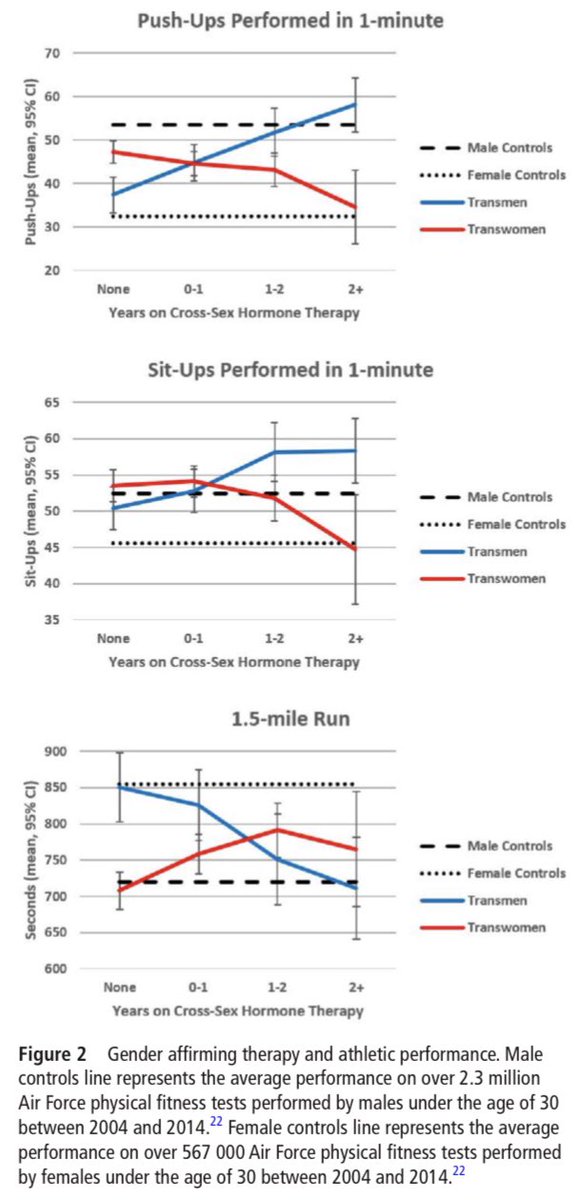https://t.co/iK6vmw9ixz
Here follows my quick first thoughts of Roberts et al., 2020.
I predict this paper will generate much discussion over the coming weeks and months.

Highly-active people, albeit not specifically-trained athletes. Mean age 26.6 yrs +/- 5.5 yrs.
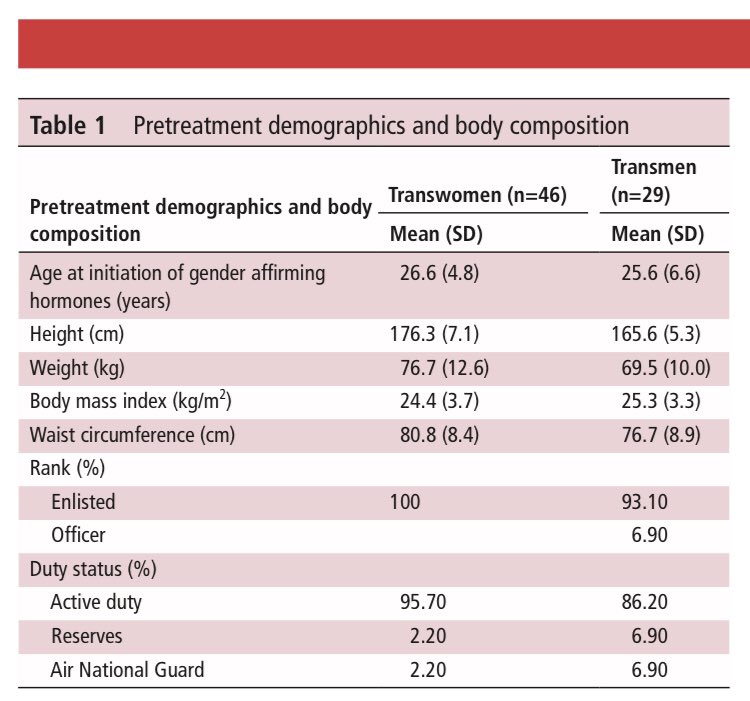
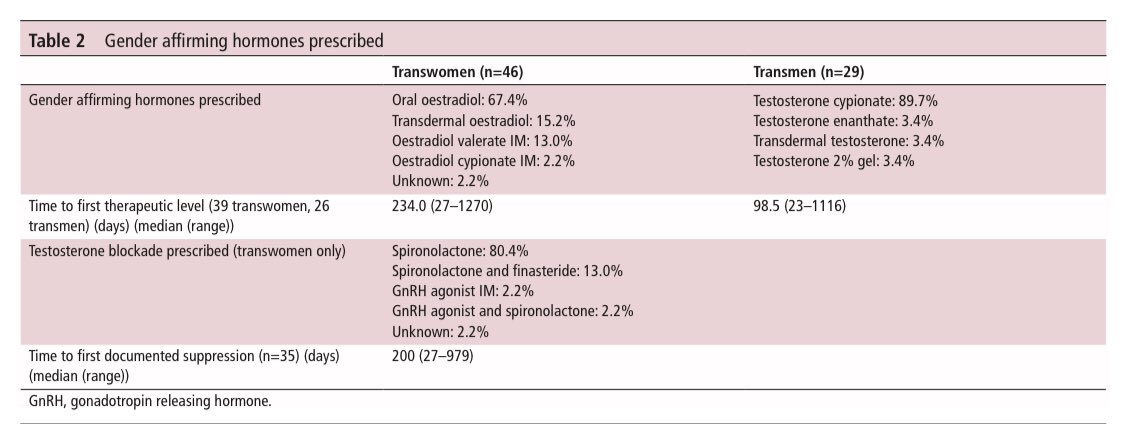
The performance of TW/TM over 30 months of treatment was retrieved from official records and compared with pre-treatment “baseline” performance.
(I think I’m reading that correctly...)
TW were weaker than control men (CM) pre-treatment and throughout transition. The authors speculate this may be explained by aversion to upper body training and its aesthetic outcomes.
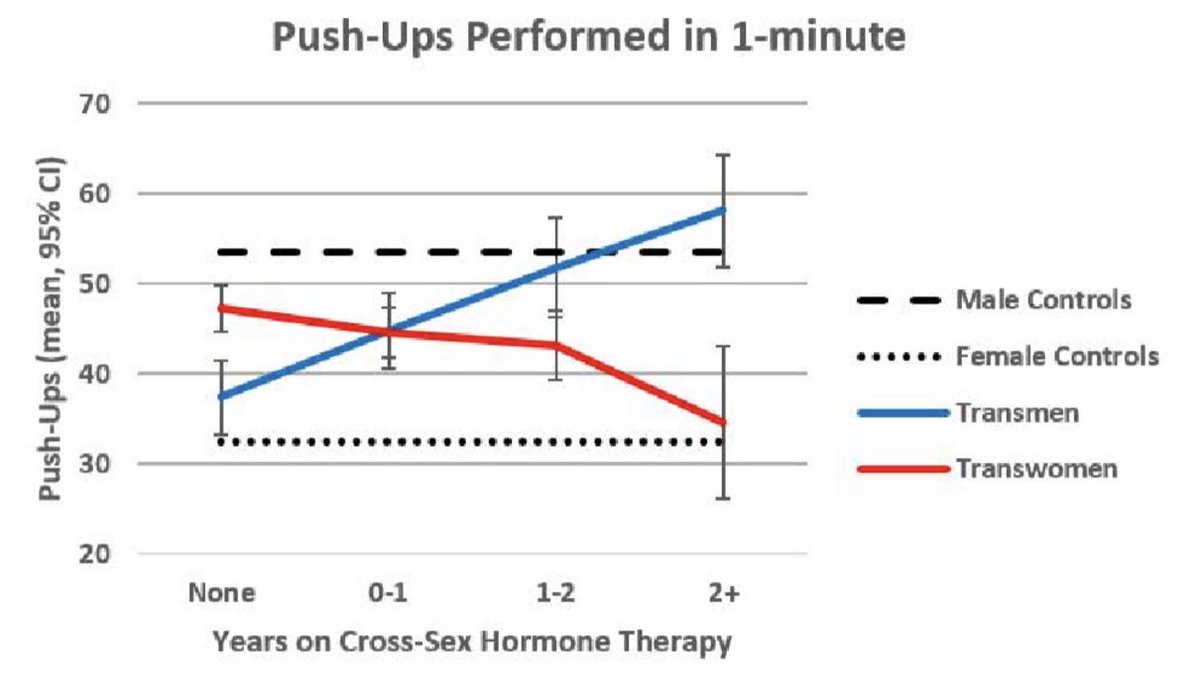
TW were equivalent to CM pre-treatment and to 2 yrs of transition. The authors argue that there is no clear aversion to abdominal training and its effect on body shape.
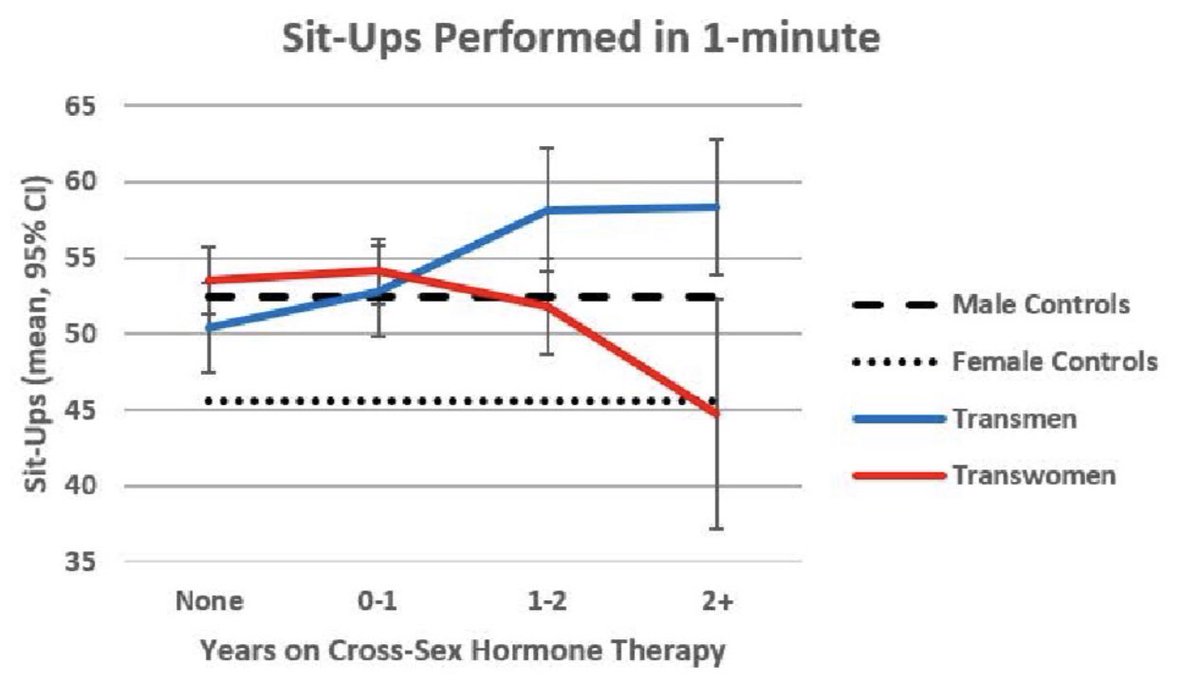
This is where it gets really interesting. While TW clearly lose speed from baseline, they appear to recover some speed after 2yrs.
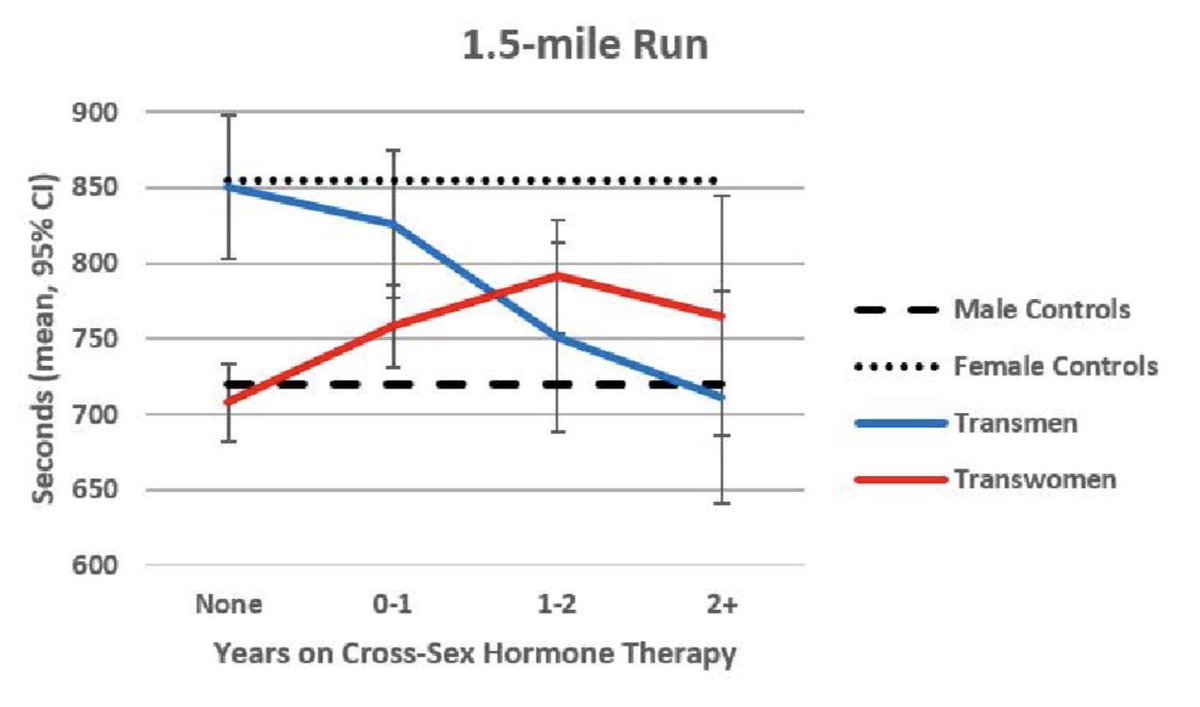
Note: ‘weak’ is relative. These females are pretty hardcore :)
The push-up/sit-up data are interesting. These fitness tests come with targets that must be reached and the targets are different for males and females. My first question is therefore: after 2 yrs of transition, are TW are being set female targets?
Is it possible the apparent sharp drop off in performance is actually an artifact of the test conditions?
Are CM not bothering more than necessary, while TM go the extra mile? The authors also speculate that, again for aesthetic reasons, TM may train - hard - and thus, genuinely outperform CM. I’m not convinced.
Could be mirrored in TM?
1. TW are genuinely losing all their muscular endurance advantage after 2 yrs, in which case the running data shows it is impossible to undo the benefits of a male skeleton.
I’d argue that, when viewed as part of the ever-increasing body of knowledge, there is a retained strength advantage *and* unaltered skeletal advantage.
Thus, this study presents far more robust running data than that of Harper 2015.
More from Emma Hilton
Fitness data from over 85k AUS children aged 9–17 yrs showed that, compared with 9 yr females, 9 yr males were 9.8% faster in sprints, 16.6% faster over 1 mile, could jump 9.5% further, could complete 33% more push-ups in 30 s and had 13.8% stronger grip.
@BARBARABULL11 @boysvswomen @cbrennansports @Martina @devarona64 Here is my full description of that data.
Example:
1.6km timed run (CV endurance)
The *best* 17 yr old girls are matched by *average* 17 yr old boys, and beaten, by some measure, by the best 9 yr old
Here is summary data from Catley and Tomkinson, 2012, who collated performance data from 85347 Australian schoolchildren aged 9-17 years old. pic.twitter.com/qKdxqywpoq
— Emma Hilton (@FondOfBeetles) November 19, 2020
@BARBARABULL11 @boysvswomen @cbrennansports @Martina @devarona64 Male advantage of a similar magnitude was detected in a study of Greek children, where, compared with 6-year-old females, 6-year-old males completed 16.6% more shuttle runs in a given time and could jump 9.7% further from a standing
@BARBARABULL11 @boysvswomen @cbrennansports @Martina @devarona64 In terms of aerobic capacity, 6- to 7-year-old males have been shown to have a higher absolute and relative (to body mass) VO2max than 6- to 7-year-old
@BARBARABULL11 @boysvswomen @cbrennansports @Martina @devarona64 Pre-puberty performance differences are not negligible, and could be mediated, to some extent, by genetic factors and/or activation of the hypothalamic–pituitary–gonadal axis during the neonatal period, sometimes referred to as “minipuberty”.
Read on.
Delighted my research article Female Sports Participation, Gender Identity and the British 2010 Equality Act is now published in Sport Ethics and Philosophy. 1/https://t.co/wNPz2sd2WD
— Cathy Devine (@cathydevine56) November 9, 2021
First, Cathy reported the numbers and % split of UK males and females playing selected sports. Male participation is higher than female participation.

Then, Cathy used population estimates to predict the numbers of male and female athletes who would be eligible, under a selfID model, for the opposite sex category. Cathy calculated these trans athletes as % of opposite sex category.
I have calculated the trans athletes as a frequency in the opposite sex category.
Here is the data for transwomen in female sports.
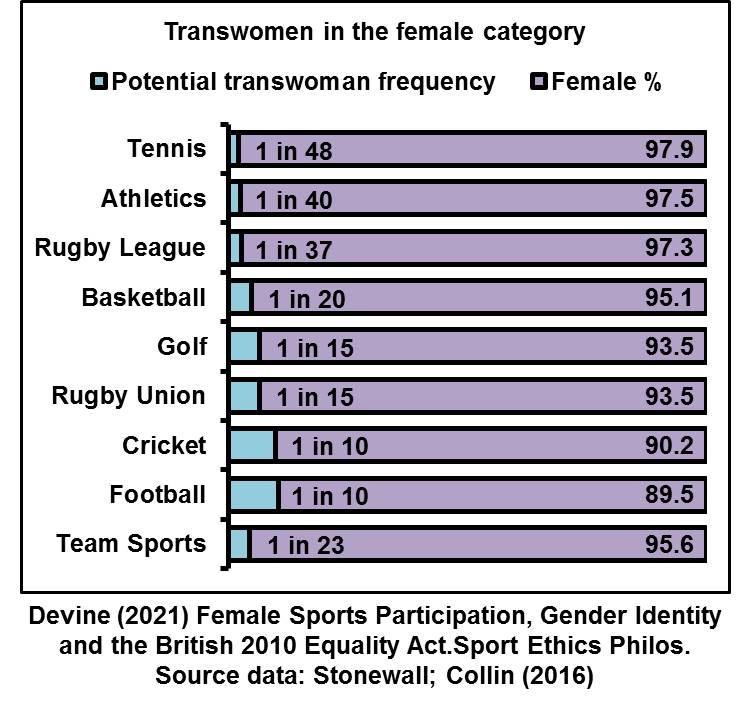
Here is the data for transmen in male sports.
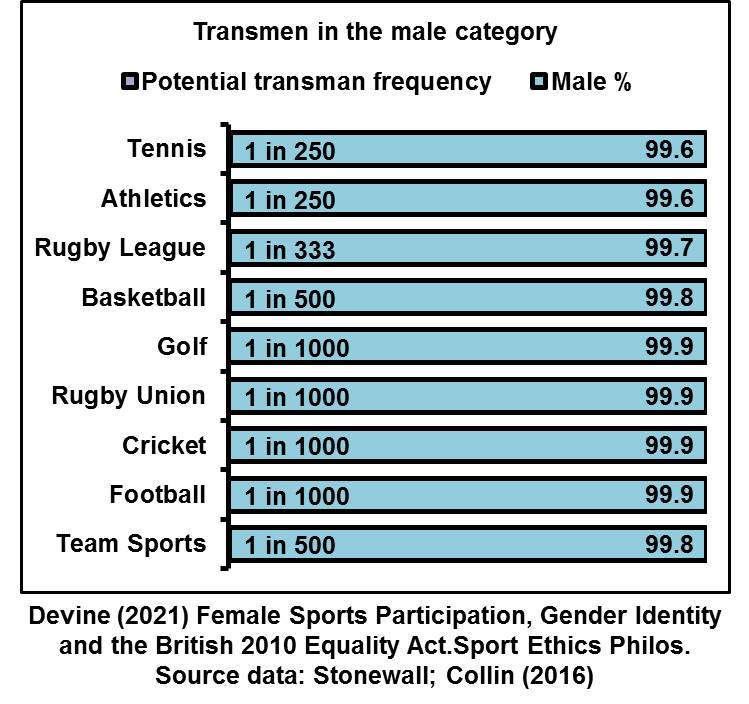
More from Transgender
The Equal Opportunities Monitoring Form in your trustee application has 'gender identity' in what apears to be a list of the protected characteristics under the Equality Act 2010.
1/11

'Gender identity' is not a protected characteristic under the Equality Act 2010 and is not defined in the Act.
https://t.co/qisFhCiV1u
2/11
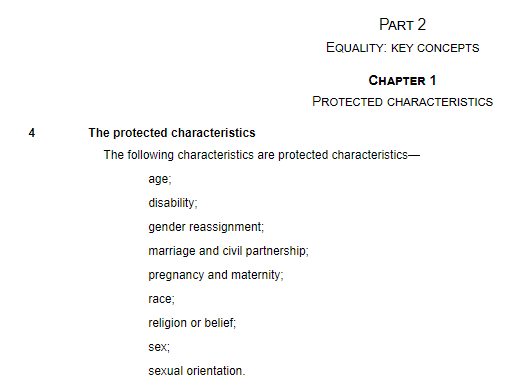
Sex is the protected characteristic under the Act, but that is not on your list.
3/11
You then ask, "Gender – I describe myself as: (please describe your gender in your own words)".
4/11
'Gender' is not a protected characteristic under the Equality Act 2010 and is not defined in the Act.
https://t.co/qisFhCiV1u
5/11
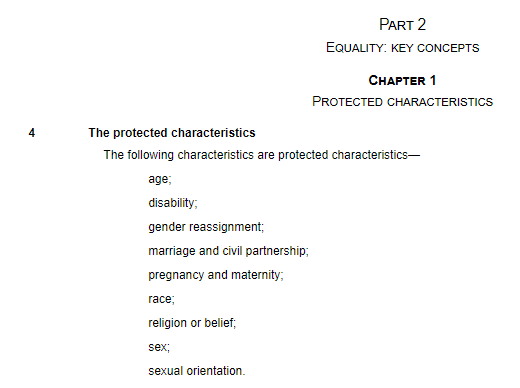
Sport in a way made my transgender self so much harder because the more well-known I become, the more difficult it become to come out as who I truly was.
— Kirsti Miller (@KirstiMiller30) July 1, 2020
2- pic.twitter.com/I7hgkLPAQa
It appears that every time an under-age Transgender person attempts to access medical care to make their lives better conservative people try to say they’re not ready for it.
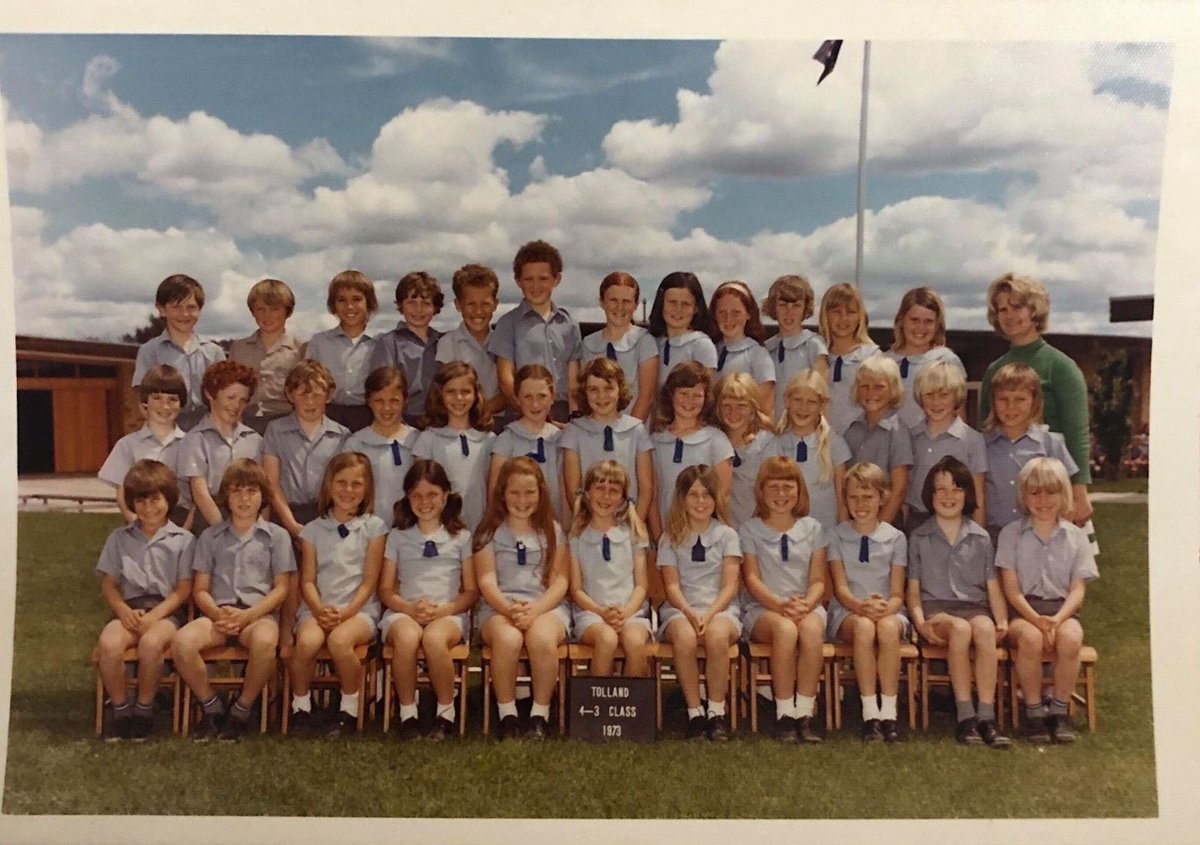
As an older transgender woman who waited until I my mid 30’s due to those same prevailing attitudes, I feel it’s sad right-wing people are still trotting out those same tired old lines.
According to them, we’re too young to know our gender pre-pubescent and when we start undergoing a puberty which doesn’t align with our gender identity apparently we’re still far too young to access puberty blockers to make the masculinisation process go away.
These people only want us to access medical care after the age of 18 and that’s when it’s far too late for many Trans women, as the whole masculinisation process [which we didn’t want in the first place] has already happened.
You May Also Like
Five billionaires share their top lessons on startups, life and entrepreneurship (1/10)
I interviewed 5 billionaires this week
— GREG ISENBERG (@gregisenberg) January 23, 2021
I asked them to share their lessons learned on startups, life and entrepreneurship:
Here's what they told me:
10 competitive advantages that will trump talent (2/10)
To outperform, you need serious competitive advantages.
— Sahil Bloom (@SahilBloom) March 20, 2021
But contrary to what you have been told, most of them don't require talent.
10 competitive advantages that you can start developing today:
Some harsh truths you probably don’t want to hear (3/10)
I\u2019ve gotten a lot of bad advice in my career and I see even more of it here on Twitter.
— Nick Huber (@sweatystartup) January 3, 2021
Time for a stiff drink and some truth you probably dont want to hear.
\U0001f447\U0001f447
10 significant lies you’re told about the world (4/10)
THREAD: 10 significant lies you're told about the world.
— Julian Shapiro (@Julian) January 9, 2021
On startups, writing, and your career:

